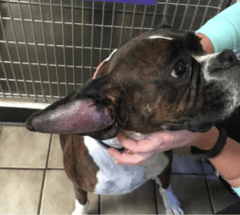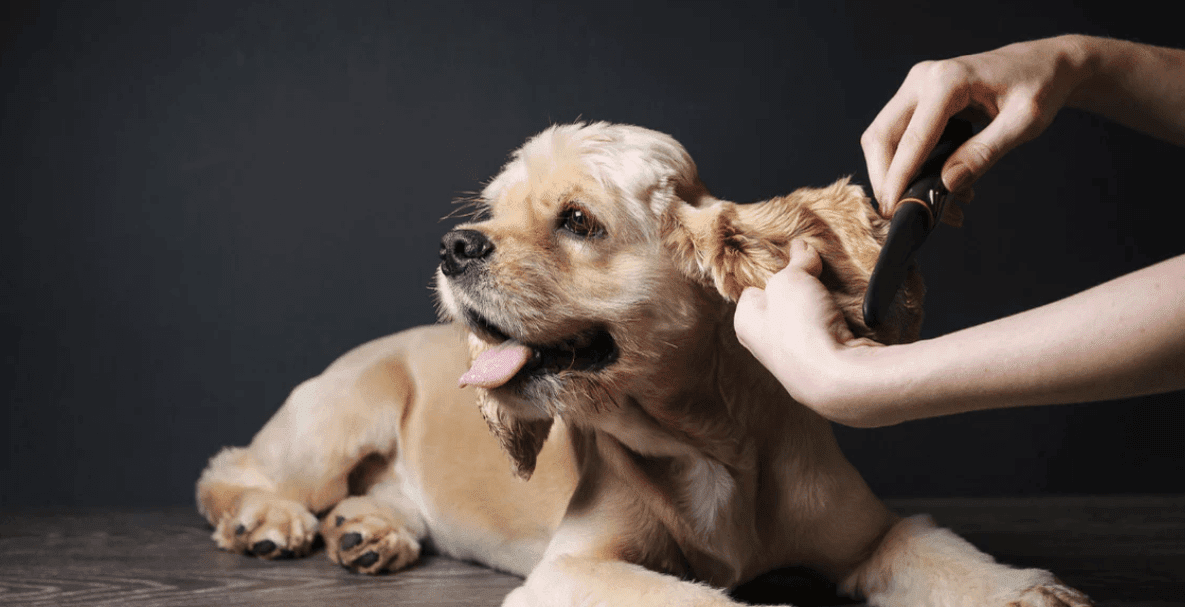Your dog may not be able to speak and let you know what's going on with their health and well-being, but when your fur baby is family you tend to share a special bond that usually signals you when something is off. Some issues are easy to detect such as if your pooch gets hurt and starts limping, or if they have an upset tummy, but other problems are not as easy to catch right away. For this reason, it is very important to be extra vigilant to be able to spot any changes in your pet. One condition that may not be as easy to spot as you may think is when a dog gets a hematoma in their ear - typically called an aural or ear hematoma. First off, you're probably asking what is a hematoma anyway?
Table of Contents
- 1. What is Dog Ear Hematoma?
- 2. What are the Signs of Hematoma in a Dog's Ear?
- 3. What Happens if an Ear Hematoma is not Treated?
- 4. Treating Your Dog's Hematoma
- 5. How do Dogs Get an Ear Hematoma?
- 6. A Closer Look at the Types of Ear Infection Treatments
- 7. Tips for Cleaning Your Dog's Ears
- 8. Four Steps to Safely Cleaning Your Dog's Ears
- Keeping a Dog's Ears Healthy
1. What is Dog Ear Hematoma?
A hematoma is a bruise or injury that causes blood to pool or swell up in one area. Because dogs often scratch their ears, rub and shake their heads a lot, the ear is the most common place for them to develop a hematoma. Whether their ears are the long and floppy types, or the straight-up pinprick types, a canine's ear flap is a fairly thin and sensitive area that can easily undergo trauma or injury causing a blood vessel to burst. When this happens in the dog's ear flap, or the thin part of the ear, the blood can start to flow between the ear cartilage and the skin causing the ear to swell up like a big balloon. So at this point, you may wonder, how can you miss this obvious sign? The problem is that it may take time for enough blood to gather in one area that it causes the ear to sell up. When this happened to Tango, my dog, the swelling took several days to become noticeable. What we noticed at first was how hot his ear was to the touch. After several days the ear also became thicker in size and that was when we started suspecting that something was wrong. The good news is that before this even happens there are usually other signs that you can watch for to spot dog ear problems before the occur.
2. What are the Signs of Hematoma in a Dog's Ear?
Anyone who has had a dog with an ear ache or any kind of ear problem can tell you it's not fun when your furry family member is not feeling well or is in pain.  If your four-legged pal won't let you pat their head. touch their ears, or even goes so far as to leading you on a merry chase around the coffee table just to avoid your touch - you can pretty much guess that something is wrong. If they also start whining, scratching their ear all the time, or shaking their head like they are dancing to the latest rap song, you can be pretty sure that there is something wrong with your dog's ear or ear canal.
If your four-legged pal won't let you pat their head. touch their ears, or even goes so far as to leading you on a merry chase around the coffee table just to avoid your touch - you can pretty much guess that something is wrong. If they also start whining, scratching their ear all the time, or shaking their head like they are dancing to the latest rap song, you can be pretty sure that there is something wrong with your dog's ear or ear canal.
When it comes to detecting a hematoma, the early signs are similar to that of any dog ear infection:
- Redness
- Constant itching or ear-scratching
- Head-shaking or tilting of the head
-
 The dog becoming lethargic or looking ill
The dog becoming lethargic or looking ill - Increase in ear temperature (where the ear is hot to the touch)
- Swelling of the ear - which may be soft or hard
- A change in how the ear looks
3. What Happens if an Ear Hematoma is not Treated?
Despite a possible change in the ear's appearance, most ear hematomas can be treated without causing any damage to the ear. If the trauma is minor, it is even possible that the blood will get reabsorbed into the dog's body on it's own. However, this can still be a slow and painful process. The danger becomes if the blood is not drained, continues to flow and pool inside the ear, and the inflammation does not subside. Once a hematoma happens, there is also an increased chance that it can recur. Not only is an ear hematoma very painful for a dog, but there is also a possibility that the bruising and buildup of the blood may cause additional ear problems to develop, including an increased risk of ear infections, so it is always best to take your pooch to a vet and get this taken care of as quickly as possible. Even if you aren't certain that the issue is a hematoma but suspect something going on with your dog's ear, it's always best to check with a reliable vet who can help diagnose the cause and the severity of the problem.
4. Treating Your Dog's Hematoma

5. How do Dogs Get an Ear Hematoma?
Most ear hematomas in dogs are a result of excessive ear scratching or aggressive shaking of the head. Because the ear flap (or the tip of the ear) is very thin, a trauma to that area, even if it is caused by the dog itself, can cause the blood vessels to break. Any dog can get a hematoma, although it is more common amongst dogs with larger ear flaps because the ear tends to flop around more and hit the skull when the dog shakes their head.
At this point you are probably asking yourself - what triggers the dog to scratch their ear to that extent? Foreign bodies, wax buildup, an injury to the ear canal, ear mites, autoimmune disorders, too much cleaning, and allergies, can all lead to an ear infection which in turn causes pain or itching making the dog scratch at their ear. Allergies especially are a significant cause: about 50 percent of dogs with allergic skin disease and 80 percent of dogs with food sensitivities are likely to get an ear infection in their lifetime.
Some of the most common causes of dog ear scratching and head shaking are: Ear infections, including dog yeast infections Allergies Immune disorders Some skin diseases Insect bites or ear mites* Trauma or injury to the ear Humidity of too much moisture in the ear *Mites, including ear mites can cause irritation in the ear and on the skin leading to hair loss, scabs, crusty skin and intense itching. Dog mites can lead to a condition called demodectic mange or scabies. Although this condition is more often seen on the body, the mites that cause mange can start out in, or spread to the ears. Because this condition causes the dog to itch terribly, it is important to look out for dog mange symptoms so that you can give your pup the mange treatment they need and prevent the dog from scratching themselves and causing an ear hematoma. Some dogs even experience chronic ear infections which may be caused by a weak immune system or some other chronic issue. If you notice your dog repeatedly scratching their ear there is usually an underlying problem that is at the root of it, so it is important to investigate all possible causes and try to treat dog ear infections early on as soon as you notice the signs. Watch for signs of your dog shaking head or dog scratching the ear, or visible signs of the dog's ear swollen. Each of these is a possible indicator of a harmful ear infection that requires treatment and a definite trip to your veterinarian. Now that you have a general sense of the underlying causes of your canine's inflammation symptoms, what's the best way to look after your dog's ears before and after an ear infection?
6. A Closer Look at the Types of Ear Infection Treatments
If the vet diagnoses the dog as having an ear infection, they may recommend one of the following methods to treat a dog for pain relief:

- Oral treatments - An antibiotic, antifungal, or steroid treatment given to heal the ear from the inside out.
- Topical treatments - A cleanser in combination with an ointment used to get deep within the ear canal.
- Surgical treatments - A medical procedure to open the ear canal and remove all toxic debris and diseased tissue
To supplement these kind of treatments, or if you are looking for a natural remedy for helping to relieve excessive itching and ear infections, try the BestLife4Pets Ear Infection & Itch Relief remedy. It's worthy to note that some ear infections may reoccur in dogs who are exposed to environmental elements often, or who are more prone to this kind of inflammation. Also, whatever medication or treatment you give, there's a chance that over time and with continued use or infection, the medicine may not work anymore.
If this happens to your best fur friend, consider a regular grooming routine and explore alternative and non-habit forming treatments, including the natural ear and itch relief homeopathic remedy mentioned above.
7. Tips for Cleaning Your Dog's Ears
Whether your dog is older or a puppy, the same prevention techniques will apply to avoid having dog ear problems. Dog ear infection treatment is one thing, but regular maintenance of your dog's fur and interior ear canal is vital to their lifelong wellness. You may have the type of dog who loves to swim often, and if so, regular ear cleaning is necessary to sweep out ocean or lake pollutants that can gather in your dog's ear and wreak havoc on their ears. There are products on the market today that are specifically designed for the healthy ear cleaning of your pup. For instance, a pH-balanced cleaner with a drying agent works wonders to alleviate any debris buildup in the ear canal.
 Some products are safer than others, so make sure to consider this when making your choice:
Some products are safer than others, so make sure to consider this when making your choice:
- Avoid hydrogen peroxide and alcohol as these two agents can kill healthy ear cells.
- Do not jam a Q-tip swab into your dog's ears as this can rupture their sensitive eardrums.
- Only use cotton balls or alcohol-free ear wipes to clean out the flaps and crevices of the ears where debris tends to build up
8. Four Steps to Safely Cleaning Your Dog's Ears
- As directed by your veterinarian, apply liquid cleanser to the ear area as gently as possible,
- Place the ear flap downward (closed) and massage the base of your canine's ear.
- Wipe the area clean with a cotton ball or soft cotton cloth, slowly and with caution
- Apply any topical ointment or medication if needed.
- Remember that dog ear infections are common, which is why it is important to take care of their ears regularly to prevent any infection or damage.
Keeping a Dog's Ears Healthy
As cute as a dog like Tango may look with their one floppy ear after their hematoma surgery, we pet owners want to always do our best to prevent dogs experiencing any pain or trauma.

Noticing and reacting to your dog’s unusual behavior is the best thing you can do to prevent any complications and to show them you love them.
Ear infections are the third most common issue that demands treatment and proper maintenance to avoid recurrence, so keeping a dog's ears healthy is the best way to avoid other complications such as ear hematoma and ear infections from occurring.
Keep your dog's ears clean, and above all, be patient and loving with your pet.
No matter how long it takes, as long as you take the necessary steps, your fur baby will get back to being healthy and pain-free!
For more tips on taking care of your dog's health, especially as they age, check out this blog on caring for your senior dog.



